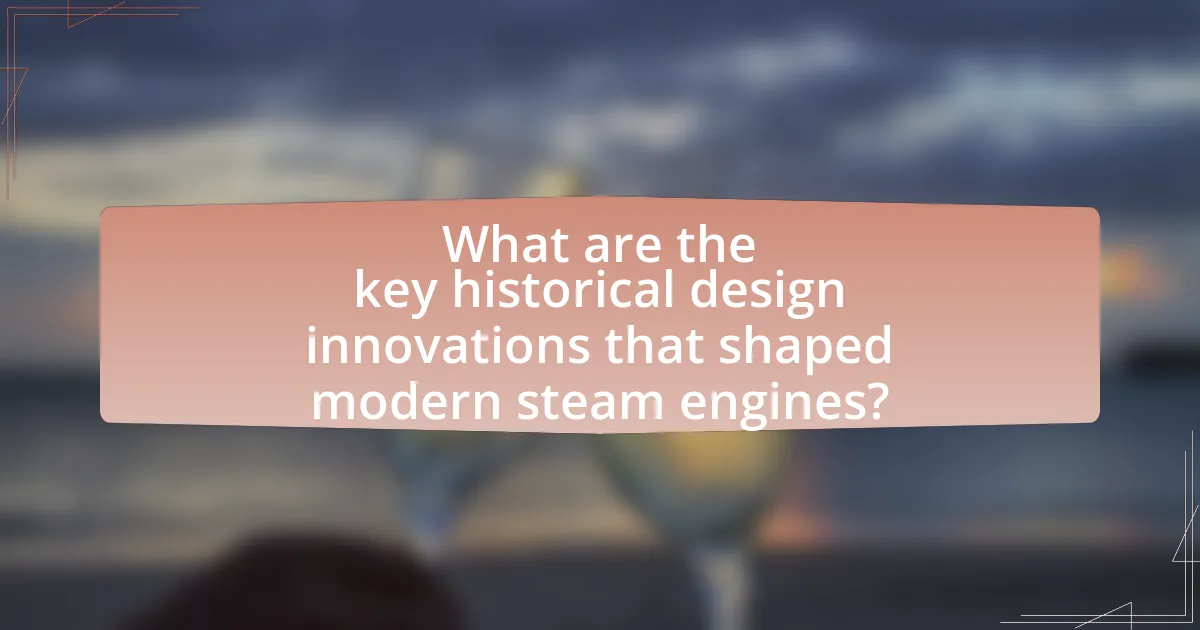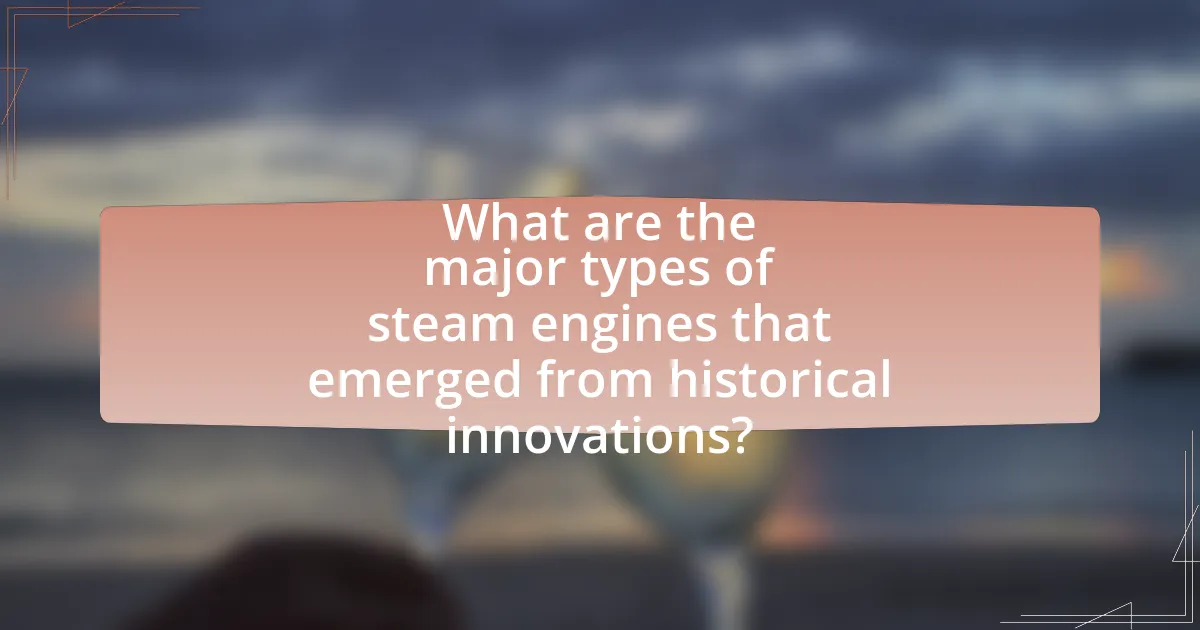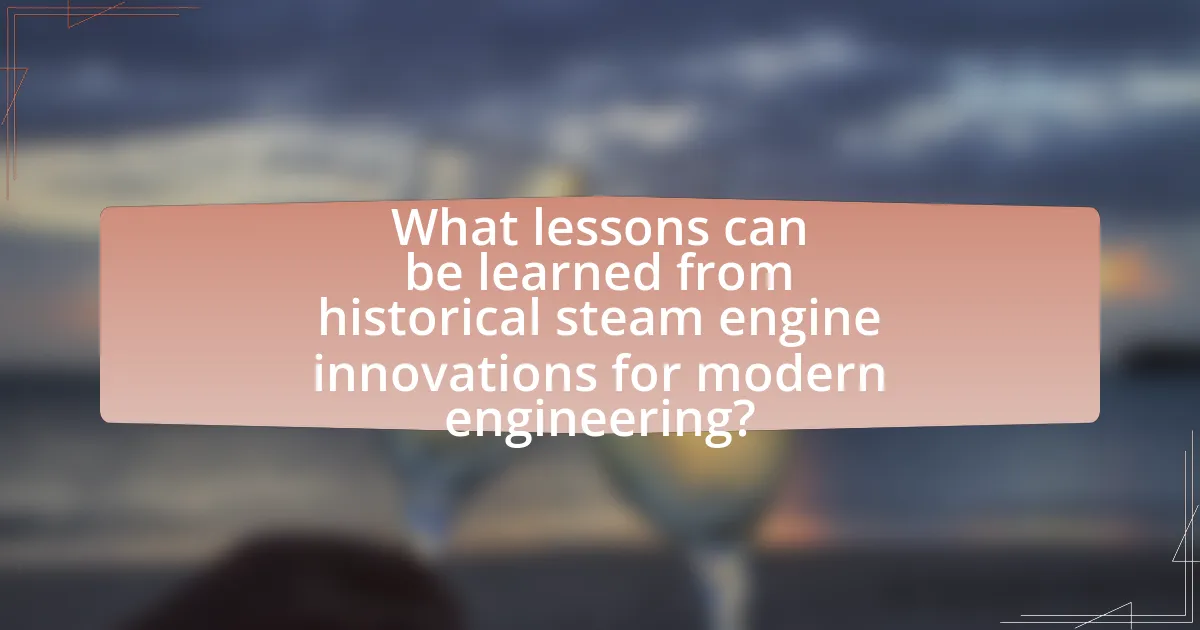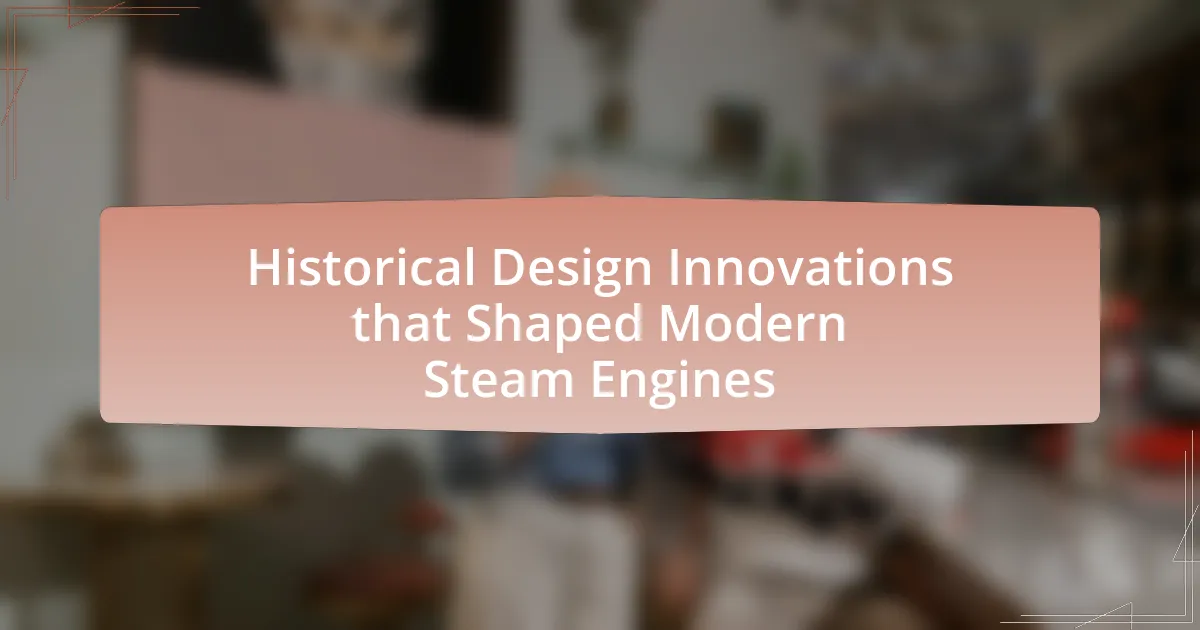The article focuses on the historical design innovations that have significantly shaped modern steam engines. Key advancements include James Watt’s separate condenser, Richard Trevithick’s high-pressure steam engine, and George Stephenson’s steam locomotive, each contributing to increased efficiency and power. The discussion highlights how early steam engine designs influenced contemporary technology, the fundamental principles behind these innovations, and the roles of notable inventors in their evolution. Additionally, it examines the impact of advancements in materials and manufacturing techniques on steam engine design, as well as the lessons modern engineers can learn from these historical developments.

What are the key historical design innovations that shaped modern steam engines?
The key historical design innovations that shaped modern steam engines include the development of the separate condenser by James Watt, the introduction of the high-pressure steam engine by Richard Trevithick, and the implementation of the steam locomotive by George Stephenson. James Watt’s separate condenser, patented in 1769, significantly improved efficiency by allowing steam to be condensed without cooling the entire cylinder, which reduced fuel consumption. Richard Trevithick’s high-pressure steam engine, created in the early 1800s, enabled smaller and more powerful engines, paving the way for locomotion. George Stephenson’s steam locomotive, built in 1814, revolutionized transportation by combining these innovations into a practical vehicle for railways, leading to the expansion of rail networks. These innovations collectively transformed steam engines into efficient, powerful machines that laid the foundation for modern engineering and transportation.
How did early steam engine designs influence modern technology?
Early steam engine designs significantly influenced modern technology by laying the foundation for the principles of thermodynamics and mechanical engineering. The innovations introduced by pioneers like Thomas Newcomen and James Watt, such as the use of a separate condenser and improved efficiency, established key concepts that are integral to contemporary engines and power generation systems. For instance, Watt’s enhancements in steam engine design, which included the rotary motion mechanism, directly contributed to the development of modern machinery and transportation systems, including trains and ships. These early designs not only advanced industrial capabilities but also spurred the creation of various technologies that rely on steam and combustion processes, demonstrating their lasting impact on today’s technological landscape.
What were the fundamental principles behind early steam engine designs?
The fundamental principles behind early steam engine designs included the conversion of heat energy into mechanical work through steam pressure. Early designs, such as Thomas Newcomen’s atmospheric engine, utilized steam to create a vacuum that drove a piston, demonstrating the principle of atmospheric pressure. Additionally, James Watt improved upon these designs by introducing a separate condenser, which increased efficiency by minimizing heat loss. These innovations laid the groundwork for the development of more advanced steam engines, significantly impacting industrialization and transportation.
How did the introduction of the steam engine revolutionize transportation?
The introduction of the steam engine revolutionized transportation by enabling the development of steam-powered locomotives and ships, significantly increasing speed and efficiency. Prior to the steam engine, transportation relied heavily on animal power and wind, which limited the capacity and speed of travel. The first successful steam locomotive, built by George Stephenson in 1814, could reach speeds of 15 miles per hour, drastically reducing travel time compared to horse-drawn vehicles. Additionally, steamships, such as those pioneered by Robert Fulton in the early 1800s, transformed maritime travel and trade by allowing vessels to navigate against currents and winds, further enhancing global commerce. This technological advancement laid the foundation for modern transportation systems, facilitating the movement of goods and people on an unprecedented scale.
What role did notable inventors play in the evolution of steam engines?
Notable inventors played a crucial role in the evolution of steam engines by introducing significant innovations that enhanced efficiency and functionality. For instance, Thomas Newcomen developed the first practical steam engine in 1712, which was used for pumping water out of mines, marking a pivotal advancement in steam technology. James Watt later improved upon Newcomen’s design in the late 18th century by introducing a separate condenser, which increased the engine’s efficiency and laid the groundwork for its use in various industries, including transportation and manufacturing. These innovations by Newcomen and Watt were instrumental in transforming steam engines from rudimentary machines into powerful tools that fueled the Industrial Revolution.
Who were the key figures in steam engine innovation?
The key figures in steam engine innovation include Thomas Newcomen, James Watt, and George Stephenson. Thomas Newcomen developed the first practical steam engine in 1712, which was used for pumping water out of mines. James Watt significantly improved the efficiency of steam engines in the late 18th century by introducing a separate condenser, which allowed for greater fuel efficiency and power output. George Stephenson further advanced steam technology by creating the first successful steam locomotive in the early 19th century, which revolutionized transportation. These contributions were pivotal in the development of steam engines, leading to their widespread use in industry and transportation.
What specific contributions did these inventors make to steam engine design?
James Watt significantly improved steam engine design by introducing the separate condenser, which increased efficiency and reduced fuel consumption. His modifications allowed steam engines to operate at higher pressures and improved their overall performance, leading to widespread adoption in various industries.
Thomas Newcomen developed the first practical steam engine for pumping water, which utilized atmospheric pressure to create a vacuum, enabling the engine to lift water from mines. This innovation laid the groundwork for future steam engine advancements.
George Stephenson contributed to steam engine design by creating the locomotive, which incorporated a multi-tube boiler and a more efficient steam distribution system. His designs facilitated the development of rail transport, revolutionizing transportation and commerce.
These inventors collectively advanced steam engine technology through innovations that enhanced efficiency, performance, and practical applications, shaping the industrial landscape.
How did advancements in materials and manufacturing impact steam engine design?
Advancements in materials and manufacturing significantly enhanced steam engine design by allowing for stronger, lighter, and more efficient components. The introduction of high-quality iron and later steel in the construction of boilers and cylinders enabled engines to withstand higher pressures, which increased their power output and efficiency. For example, the use of cast iron for boiler construction in the early 19th century improved durability and safety, as seen in the designs of engineers like George Stephenson. Additionally, precision manufacturing techniques, such as the use of interchangeable parts, streamlined assembly processes and reduced maintenance costs, further optimizing steam engine performance. These innovations collectively contributed to the widespread adoption and evolution of steam engines during the Industrial Revolution.
What materials were crucial in the development of more efficient steam engines?
Iron and steel were crucial materials in the development of more efficient steam engines. The use of cast iron allowed for stronger and more durable engine components, while wrought iron and later steel provided the necessary tensile strength for high-pressure steam applications. These materials enabled the construction of boilers that could withstand greater pressures, leading to increased efficiency and power output. Historical advancements, such as the introduction of the steam engine by James Watt in the late 18th century, showcased the importance of these materials, as they facilitated the transition from low-pressure to high-pressure steam engines, significantly enhancing performance and reliability.
How did manufacturing techniques evolve alongside steam engine technology?
Manufacturing techniques evolved significantly alongside steam engine technology by transitioning from manual craftsmanship to mechanized production methods. The introduction of steam engines in the late 18th century enabled factories to increase production speed and efficiency, leading to the adoption of assembly line techniques. For instance, the use of steam-powered machinery allowed for the mass production of components, such as gears and pistons, which were essential for steam engines. This shift was exemplified by the establishment of factories like Matthew Boulton’s in Birmingham, which utilized steam power to enhance manufacturing processes. Consequently, the synergy between steam engine advancements and manufacturing techniques not only improved productivity but also laid the groundwork for the Industrial Revolution, fundamentally transforming industries and economies.

What are the major types of steam engines that emerged from historical innovations?
The major types of steam engines that emerged from historical innovations include the atmospheric engine, the high-pressure engine, and the compound engine. The atmospheric engine, developed by Thomas Newcomen in the early 18th century, utilized atmospheric pressure to drive a piston and was primarily used for pumping water. The high-pressure engine, pioneered by James Watt in the late 18th century, operated at higher steam pressures, significantly improving efficiency and power output. The compound engine, introduced in the 19th century, utilized multiple cylinders to expand steam in stages, further enhancing efficiency and reducing fuel consumption. These innovations collectively transformed steam engine technology and laid the groundwork for modern steam engines.
How do different types of steam engines compare in terms of design and function?
Different types of steam engines, such as the simple steam engine, compound steam engine, and locomotive steam engine, vary significantly in design and function. The simple steam engine operates on a single cylinder and uses steam to create motion directly, making it straightforward but less efficient. In contrast, the compound steam engine employs multiple cylinders, allowing steam to expand in stages, which increases efficiency and power output. The locomotive steam engine, specifically designed for rail transport, integrates features like a large boiler and driving wheels to maximize traction and speed, showcasing a specialized adaptation of steam technology for transportation. These design variations reflect advancements in engineering aimed at improving efficiency, power, and application in various contexts.
What distinguishes a locomotive steam engine from a stationary steam engine?
A locomotive steam engine is designed for mobility and operates on tracks, while a stationary steam engine is fixed in place and used for powering machinery. The key distinction lies in their intended use; locomotive engines are built to generate propulsion for trains, utilizing a boiler and pistons to convert steam pressure into mechanical energy for movement. In contrast, stationary engines are typically employed in factories or mills, where they provide power to various equipment without the need for mobility. Historical advancements in locomotive design, such as the introduction of the steam locomotive by George Stephenson in the early 19th century, further emphasize their role in transportation, contrasting with the stationary engines that powered industrial processes during the same period.
How did compound steam engines improve efficiency over earlier models?
Compound steam engines improved efficiency over earlier models by utilizing multiple cylinders to expand steam in stages, which allowed for better energy extraction from the steam. This design reduced the amount of steam wasted and increased the overall thermal efficiency of the engine. For example, in a typical compound engine, high-pressure steam first enters a high-pressure cylinder, then the exhaust steam is directed into a low-pressure cylinder, allowing the steam to do more work before being released. This method can achieve efficiencies of up to 20% greater than single-cylinder engines, as demonstrated in the work of engineers like James Watt and later developments in the 19th century.
What innovations in steam engine design led to increased power and efficiency?
Innovations in steam engine design that led to increased power and efficiency include the introduction of the separate condenser, the use of high-pressure steam, and the development of the compound steam engine. The separate condenser, invented by James Watt in the late 18th century, allowed steam to be condensed without cooling the cylinder, significantly reducing energy loss and improving efficiency by up to 75%. High-pressure steam, utilized in later designs, enabled engines to produce more power from the same amount of fuel, enhancing overall performance. The compound steam engine, which uses steam in multiple stages, further increased efficiency by allowing the steam to expand and do work in several cylinders, maximizing energy extraction. These innovations collectively transformed steam engines into more powerful and efficient machines, facilitating advancements in transportation and industry during the Industrial Revolution.
How did the introduction of superheating change steam engine performance?
The introduction of superheating significantly improved steam engine performance by increasing thermal efficiency and power output. Superheating involves raising the temperature of steam beyond its saturation point, which reduces the moisture content in the steam and allows for more energy to be harnessed during the expansion process. This innovation led to a notable increase in the efficiency of steam engines, with some designs achieving thermal efficiencies of over 20%, compared to around 10% for saturated steam engines. Consequently, superheated steam engines could operate at higher pressures and temperatures, resulting in greater power generation and reduced fuel consumption.
What impact did the development of the steam turbine have on steam engine technology?
The development of the steam turbine significantly advanced steam engine technology by enhancing efficiency and power output. Unlike traditional reciprocating steam engines, steam turbines convert thermal energy directly into mechanical energy through rotational motion, which allows for smoother operation and higher speeds. This innovation led to the widespread adoption of steam turbines in various applications, including marine propulsion and electricity generation, as they could produce more power with less fuel consumption. For instance, the introduction of steam turbines in naval ships during the early 20th century resulted in vessels that were faster and more efficient than those powered by conventional steam engines.

What lessons can be learned from historical steam engine innovations for modern engineering?
Historical steam engine innovations teach modern engineering the importance of iterative design, efficiency optimization, and the integration of new materials. The development of the steam engine involved continuous improvements, such as James Watt’s enhancements in the late 18th century, which increased efficiency by introducing a separate condenser, demonstrating that refining existing technologies can yield significant performance gains. Additionally, the use of lightweight materials in steam engines, like cast iron and later steel, highlights the necessity of material selection in engineering design to improve durability and reduce weight. These historical lessons emphasize that modern engineering can benefit from a focus on incremental innovation, material advancements, and the pursuit of efficiency in design processes.
How can historical design principles be applied to contemporary engineering challenges?
Historical design principles can be applied to contemporary engineering challenges by leveraging proven methodologies such as modularity, simplicity, and efficiency. For instance, the modular design of early steam engines allowed for easier maintenance and scalability, which can inform modern engineering practices in developing adaptable systems. Additionally, the emphasis on simplicity in historical designs, such as the straightforward mechanics of the Watt steam engine, can guide contemporary engineers to create more user-friendly and reliable technologies. The efficiency achieved through these historical designs, exemplified by the high thermal efficiency of the Cornish engine, serves as a benchmark for modern engineers aiming to optimize energy use in current systems.
What are the best practices derived from historical steam engine innovations?
The best practices derived from historical steam engine innovations include the implementation of efficient heat exchange systems, the use of high-pressure steam for increased power output, and the adoption of modular design for easier maintenance and scalability. Efficient heat exchange systems, such as those developed by James Watt in the late 18th century, significantly improved fuel efficiency and reduced operational costs. The use of high-pressure steam, pioneered by engineers like Richard Trevithick, allowed for more powerful engines, enhancing performance in transportation and industry. Additionally, modular design principles, which emerged from the need for easier repairs and upgrades, have influenced modern engineering practices, promoting reliability and adaptability in steam engine technology. These practices have been validated through historical advancements that led to increased efficiency and effectiveness in steam engine applications.
How can modern engineers draw inspiration from the evolution of steam engines?
Modern engineers can draw inspiration from the evolution of steam engines by studying their innovative design principles and efficiency improvements. The steam engine’s transition from simple designs to more complex systems, such as the introduction of the condensing engine by James Watt in the late 18th century, showcases how iterative advancements can lead to significant performance gains. This historical progression emphasizes the importance of refining existing technologies, which modern engineers can apply to contemporary challenges in energy efficiency and sustainability. Furthermore, the steam engine’s role in the Industrial Revolution illustrates the impact of engineering on societal transformation, encouraging today’s engineers to consider the broader implications of their designs on society and the environment.
What are the common challenges faced in steam engine design and how were they overcome?
Common challenges in steam engine design included efficiency, heat loss, and material limitations. Engineers addressed efficiency by developing the condensing steam engine, which reused steam to improve fuel economy. Heat loss was mitigated through better insulation and the introduction of multi-stage expansion, allowing steam to do more work before being exhausted. Material limitations were overcome by using stronger alloys and advancements in metallurgy, enabling engines to withstand higher pressures and temperatures, thus enhancing performance and reliability.
What troubleshooting techniques were developed in response to steam engine failures?
In response to steam engine failures, several troubleshooting techniques were developed, including systematic inspection protocols, pressure testing, and the implementation of safety valves. Systematic inspection protocols involved regular checks of critical components such as boilers, pistons, and valves to identify wear and potential failure points. Pressure testing was utilized to ensure that boilers could withstand operational pressures without leaking or bursting, which was crucial for safety. The introduction of safety valves allowed for the automatic release of excess steam pressure, preventing catastrophic failures. These techniques were essential in improving the reliability and safety of steam engines, as evidenced by the reduction in accidents and increased operational efficiency during the Industrial Revolution.
How can understanding past innovations help in future steam engine developments?
Understanding past innovations can significantly inform future steam engine developments by providing insights into design efficiencies and technological advancements. Historical innovations, such as James Watt’s improvements in the late 18th century, introduced concepts like the separate condenser, which enhanced efficiency and reduced fuel consumption. Analyzing these advancements allows engineers to identify successful design principles and apply them to modern materials and technologies, potentially leading to more efficient and environmentally friendly steam engines. For instance, the integration of computer-aided design (CAD) tools today can optimize these historical designs, resulting in engines that are both powerful and sustainable.


